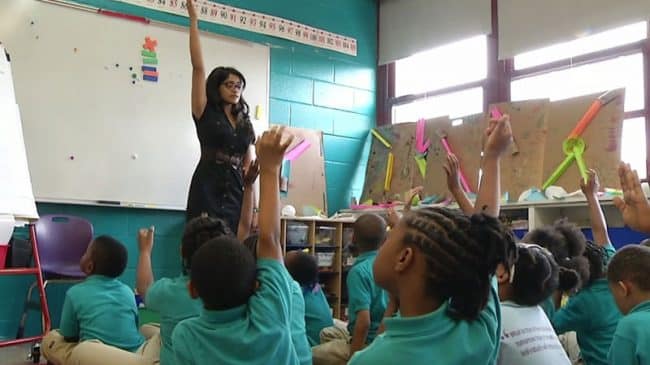Jill Kelly’s recent piece called it “a mistake” for the New Haven Board of Education to move to a Weighted Student Formula. Like Kelly, I’m equally concerned about ensuring all children have opportunities for a quality education. But as someone who studies school finance reform for a living and has seen the impact of Weighted Student Formulas across the country, Jill’s perceptions could not be further from the truth.
Adopting a Weighted Student Formula (WSF) would enable kids’ education dollars to follow them wherever they attend school. It makes implicit sense that districts should allot resources to their schools based on where the students are and what individual needs their students have. WSF accomplishes both and has already been adopted in over 35 cities. WSF keeps the focus where it belongs-on kids, not adults and abstract programs. The formula also gives principals the flexibility to use their local knowledge to best decide how to meet the needs of their students, and provides the transparency to properly hold failure to account. WSF has been so effective where implemented, that a recent survey found that over 87 percent of principals currently using the formula would keep it.
Kelly’s concerns come down to three broad points: equity, accountability, and a misplaced fear of competition. An evidence-based assessment of WSF shows that all three points are unfounded.
First, equity. Kelly argues that fairer funding may not lead to fairer outcomes. Kelly’s fears about the future ignore that New Haven Public Schools are already abysmally unfair. A study conducted last year by Education Resource Strategies (ERS) showed that despite receiving state funding on par with similar districts around the country, New Haven’s per-student school funding has huge disparities. The top-funded K-8 school, Betsy Ross, received nearly twice as many per-pupil dollars as its lowest funded counterpart, Bishop Woods.
If Betsy Ross’ students had significantly higher obstacles to a quality education than Bishop Woods’ the disparity might make sense. But both schools serve high-need populations. At Betsy Ross, just under three-quarters of the student body is eligible for free or reduced lunch, since they come from low-income families. However at Bishop Woods, the proportion is even higher, exceeding 80 percent. These unfair disparities are a systemic feature of the flawed status quo Kelly defends.
School districts that have adopted WSF have seen these kinds of funding inequities evaporate. In 2008, the year before Baltimore adopted WSF, over half of its schools had per-student funding at 10 percent above or below the district average. Two years into WSF, 80 percent of Baltimore’s public schools were within the 10 percent range.
As Kelly says, equity is about outcomes too, and WSF has facilitated improvement around the country. The Reason Foundation’s Weighted Student Formula Yearbook documents how New Haven’s sister district, Hartford, has used WSF to great success since 2009. A 2012 study by Public Impact showed that Hartford schools with the highest need populations consistently received more per-pupil resources. One school took advantage of the extra dollars to create a better equipped special education resource room for its students with more staff. New Orleans took WSF further than any other city after Hurricane Katrina. Before the disaster, New Orleans only graduated 5 percent of its special education students. Afterward, the Louisiana Recovery District reformed the city’s school finance system to make 98 percent of funding followed the child. By 2013, special education graduation rates shot up nearly ten-fold.
This brings us to accountability. If quality and equity are priorities, New Haven parents deserve a formula that makes it easier to reward success and identify failure. Right now, New Haven’s funding system is anything but transparent. Its confusing morass of categorical investments are only tangentially based on perceptions of schools’ needs, not the individual kids in them. In fact, the same ERS study mentioned earlier found that over half of New Haven’s school funding variations come down to “ad hoc exceptions” and “unexplained variation.” How can parents hold their principals and district accountable if the current system makes it impossible to identify the problems?
Kelly assumes principals will simply not fund necessary resources once they have the autonomy over their school budgets. But principals interact with their students every day and know far better what they actually need than central office administrators.
Finally, Kelly claims that WSF will “commodify” kids and introduce a toxic “zero-sum” mindset in public education. But public education funding is already a zero-sum game. It’s a limited resource, and we owe it to our kids and our fellow taxpayers to ensure that what we spend is being shared as fairly and as effectively as possible to best serve our children. What Kelly doesn’t realize is that status quo public school funding already creates a “survival of the fittest” atmosphere, where the politically-connected win.
No matter what sentiment we want to attach to it, education is still a service we pay for and receive, like anything else in the economy. Not recognizing this and accordingly creating the best possible incentives just hurts our kids. Weighted Student Formulas don’t sabotage public education. They bring it into the 21st century. Encouraging innovation and competition between schools doesn’t commodify students, it’s the best thing we can do to give them a great shot at the future.
